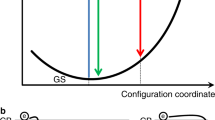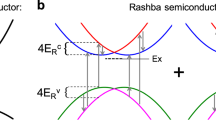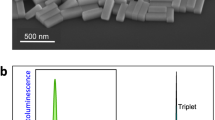Abstract
Lead halide perovskites have emerged as promising new semiconductor materials for high-efficiency photovoltaics, light-emitting applications and quantum optical technologies. Their luminescence properties are governed by the formation and radiative recombination of bound electron–hole pairs known as excitons, whose bright or dark character of the ground state remains unknown and debated. While symmetry analysis predicts a singlet non-emissive ground exciton topped with a bright exciton triplet, it has been predicted that the Rashba effect may reverse the bright and dark level ordering. Here, we provide the direct spectroscopic signature of the dark exciton emission in the low-temperature photoluminescence of single formamidinium lead bromide perovskite nanocrystals under magnetic fields. The dark singlet is located several millielectronvolts below the bright triplet, in fair agreement with an estimation of the long-range electron–hole exchange interaction. Nevertheless, these perovskites display an intense luminescence because of an extremely reduced bright-to-dark phonon-assisted relaxation.
This is a preview of subscription content, access via your institution
Access options
Access Nature and 54 other Nature Portfolio journals
Get Nature+, our best-value online-access subscription
$29.99 / 30 days
cancel any time
Subscribe to this journal
Receive 12 print issues and online access
$259.00 per year
only $21.58 per issue
Buy this article
- Purchase on Springer Link
- Instant access to full article PDF
Prices may be subject to local taxes which are calculated during checkout





Similar content being viewed by others
Data availability
All relevant data that support our experimental findings are available from the corresponding author upon reasonable request.
References
Correa-Baena, J.-P. et al. Promises and challenges of perovskite solar cells. Science 358, 739–744 (2017).
Tan, Z.-K. et al. Bright light-emitting diodes based on organometal halide perovskite. Nat. Nanotechnol. 9, 687–692 (2014).
Yuan, M. et al. Perovskite energy funnels for efficient light-emitting diodes. Nat. Nanotechnol. 11, 872–877 (2016).
Zhang, X. et al. Enhancing the brightness of cesium lead halide perovskite nanocrystal based green light-emitting devices through the interface engineering with perfluorinated ionomer. Nano Lett. 16, 1415–1420 (2016).
Yuan, Z. et al. One-dimensional organic lead halide perovskites with efficient bluish white-light emission. Nat. Commun. 8, 14051 (2017).
Zhu, H. L. et al. Room-temperature solution-processed NiOx:PbI2 nanocomposite structures for realizing high-performance perovskite photodetectors. ACS Nano 10, 6808–6815 (2016).
Xing, G. et al. Low-temperature solution-processed wavelength-tunable perovskites for lasing. Nat. Mater. 13, 476–480 (2014).
Zhu, H. et al. Lead halide perovskite nanowire lasers with low lasing thresholds and high quality factors. Nat. Mater. 14, 636–642 (2015).
Xing, J. et al. Vapor phase synthesis of organometal halide perovskite nanowires for tunable room-temperature nanolasers. Nano Lett. 15, 4571–4577 (2015).
Xu, Y. et al. Two-photon-pumped perovskite semiconductor nanocrystal lasers. J. Am. Chem. Soc. 138, 3761–3768 (2016).
Bonadeo, N. H. et al. Coherent optical control of the quantum state of a single quantum dot. Science 282, 1473–1476 (1998).
Li, X. et al. An all-optical quantum gate in a semiconductor quantum dot. Science 301, 809–811 (2003).
Benson, O., Santori, C., Pelton, M. & Yamamoto, Y. Regulated and entangled photons from a single quantum dot. Phys. Rev. Lett. 84, 2513–2516 (2000).
Stevenson, R. M. et al. A semiconductor source of triggered entangled photon pairs. Nature 439, 179–182 (2006).
Kim, M., Im, J., Freeman, A. J., Ihm, J. & Jin, H. Switchable S = 1/2 and J = 1/2 Rashba bands in ferroelectric halide perovskites. Proc. Natl Acad. Sci. USA 111, 6900–6904 (2014).
Zheng, F., Tan, L. Z., Liu, S. & Rappe, A. M. Rashba spin–orbit coupling enhanced carrier lifetime in CH3NH3PbI3. Nano Lett. 15, 7794–7800 (2015).
Kepenekian, M. et al. Rashba and Dresselhaus effects in hybrid organic–inorganic perovskites: from basics to devices. ACS Nano 9, 11557–11567 (2015).
Tanaka, K. et al. Comparative study on the excitons in lead-halide-based perovskite-type crystals CH3NH3PbBr3 CH3NH3PbI3. Solid State Commun. 127, 619–623 (2003).
Even, J. Pedestrian guide to symmetry properties of the reference cubic structure of 3D all-inorganic and hybrid perovskites. J. Phys. Chem. Lett. 6, 2238–2242 (2015).
Fu, M. et al. Neutral and charged exciton fine structure in single lead halide perovskite nanocrystals revealed by magneto-optical spectroscopy. Nano Lett. 17, 2895–2901 (2017).
Nestoklon, M. O. et al. Optical orientation and alignment of excitons in ensembles of inorganic perovskite nanocrystals. Phys. Rev. B 97, 235304 (2018).
Yin, C. et al. Bright-exciton fine-structure splittings in single perovskite nanocrystals. Phys. Rev. Lett. 119, 026401 (2017).
Ramade, J. et al. Exciton-phonon coupling in a CsPbBr3 single nanocrystal. Appl. Phys. Lett. 112, 072104 (2018).
Ramade, J. et al. Fine structure of excitons and electron–hole exchange energy in polymorphic CsPbBr3 single nanocrystals. Nanoscale 10, 6393–6401 (2018).
Isarov, M. et al. Rashba effect in a single colloidal CsPbBr3 perovskite nanocrystal detected by magneto-optical measurements. Nano Lett. 17, 5020–5026 (2017).
Becker, M. A. et al. Bright triplet excitons in caesium lead halide perovskites. Nature 553, 189–193 (2018).
Sercel, P. C. & Efros, A. L. Band-edge exciton in CdSe and other II−VI and III−V compound semiconductor nanocrystals—revisited. Nano Lett. 18, 4061–4068 (2018).
Yaffe, O. et al. Local polar fluctuations in lead halide perovskite crystals. Phys. Rev. Lett. 118, 136001 (2017).
Canneson, D. et al. Negatively charged and dark excitons in CsPbBr3 perovskite nanocrystals revealed by high magnetic fields. Nano Lett. 17, 6177–6183 (2017).
Chen, L. et al. Composition-dependent energy splitting between bright and dark excitons in lead halide perovskite nanocrystals. Nano Lett. 18, 2074–2080 (2018).
Xu, K., Vliem, J. F. & Meijerink, A. Long-lived dark exciton emission in Mn-doped CsPbCl3. J. Phys. Chem. C 123, 979–984 (2019).
Dar, M. I. et al. Origin of unusual bandgap shift and dual emission in organic-inorganic lead halide perovskites. Sci. Adv. 2, e1601156 (2016).
Wright, A. D. et al. Electron–phonon coupling in hybrid lead halide perovskites. Nat. Commun. 7, 11755 (2016).
Schueller, E. C. et al. Crystal structure evolution and notable thermal expansion in hybrid perovskites formamidinium tin iodide and formamidinium lead bromide. Inorg. Chem. 57, 695–701 (2017).
Sinito, C. et al. Tailoring the exciton fine structure of cadmium selenide nanocrystals with shape anisotropy and magnetic field. ACS Nano 8, 11651–11656 (2014).
Fernée, M. J., Tamarat, P. & Lounis, B. Spectroscopy of single nanocrystals. Chem. Soc. Rev. 43, 1311–1337 (2014).
Sapori, D., Kepenekian, M., Pedesseau, L., Katan, C. & Even, J. Quantum confinement and dielectric profiles of colloidal nanoplatelets of halide inorganic and hybrid organic–inorganic perovskites. Nanoscale 8, 6369–6378 (2016).
Rainò, G. et al. Single cesium lead halide perovskite nanocrystals at low temperature: fast single-photon emission, reduced blinking, and exciton fine structure. ACS Nano 10, 2485–2490 (2016).
Yu, Z. G. Effective-mass model and magneto-optical properties in hybrid perovskites. Sci. Rep. 6, 28576 (2016).
Bayer, M. et al. Electron and hole g factors and exchange interaction from studies of the exciton fine structure in In0.60Ga0.40As quantum dots. Phys. Rev. Lett. 82, 1748–1751 (1999).
Bayer, M. et al. Fine structure of neutral and charged excitons in self-assembled In(Ga)As/(Al)GaAs quantum dots. Phys. Rev. B 65, 195315 (2002).
Htoon, H. et al. Anomalous circular polarization of photoluminescence spectra of individual CdSe nanocrystals in an applied magnetic field. Phys. Rev. Lett. 102, 017402 (2009).
Fu, M. et al. Unraveling exciton–phonon coupling in individual FAPbI3 nanocrystals emitting near-infrared single photons. Nat. Commun. 9, 3318 (2018).
Morello, G. et al. Temperature and size dependence of nonradiative relaxation and exciton−phonon coupling in colloidal CdTe quantum dots. J. Phys. Chem. C 111, 5846–5849 (2007).
Gauthron, K. et al. Optical spectroscopy of two-dimensional layered (C6H5C2H4-NH3)2-PbI4 perovskite. Opt. Express 18, 5913–5919 (2010).
Pfingsten, O. et al. Phonon interaction and phase transition in single formamidinium lead bromide quantum dots. Nano Lett. 18, 4440–4446 (2018).
Shinde, A., Gahlaut, R. & Mahamuni, S. Low-temperature photoluminescence studies of CsPbBr3 quantum dots. J. Phys. Chem. C 121, 14872–14878 (2017).
Labeau, O., Tamarat, P. & Lounis, B. Temperature dependence of the luminescence lifetime of single CdSe/ZnS quantum dots. Phys. Rev. Lett. 90, 257404 (2003).
Biadala, L., Louyer, Y., Tamarat, P. & Lounis, B. Direct observation of the two lowest exciton zero-phonon lines in single CdSe/ZnS nanocrystals. Phys. Rev. Lett. 103, 037404 (2009).
Takagahara, T. Electron-phonon interactions and excitonic dephasing in semiconductor nanocrystals. Phys. Rev. Lett. 71, 3577–3580 (1993).
Neukirch, A. J. et al. Polaron stabilization by cooperative lattice distortion and cation rotations in hybrid perovskite materials. Nano Lett. 16, 3809–3816 (2016).
Miyata, K., Atallah, T. L. & Zhu, X.-Y. Lead halide perovskites: crystal-liquid duality, phonon glass electron crystals, and large polaron formation. Sci. Adv. 3, e1701469 (2017).
Ferreira, A. C. et al. Elastic softness of hybrid lead halide perovskites. Phys. Rev. Lett. 121, 085502 (2018).
Frohna, K. et al. Inversion symmetry and bulk Rashba effect in methylammonium lead iodide perovskite single crystals. Nat. Commun. 9, 1829 (2018).
Protesescu, L. et al. Monodisperse formamidinium lead bromide nanocrystals with bright and stable green photoluminescence. J. Am. Chem. Soc. 138, 14202–14205 (2016).
Acknowledgements
We acknowledge the financial support from the French National Agency for Research, Région Aquitaine, Idex Bordeaux (LAPHIA Program) and the French Ministry of Education and Research. J.E. and B.L. acknowledge the Institut universitaire de France.
Author information
Authors and Affiliations
Contributions
M.I.B. and M.V.K. prepared the samples. M.I.B., M.V.K and R.E. performed the ensemble characterization. P.T. performed the optical experiments. P.T., J.-B.T. and B.L. interpreted the data, which were analysed by P.T. and J.-B.T. B.L. and P.T. modelled the evolutions of the spectra and decay rates with temperature and magnetic fields. J.E. developed the model of exchange interaction. P.T., J.E. and B.L. wrote the manuscript with input from all authors. B.L. supervised the project.
Corresponding author
Ethics declarations
Competing interests
The authors declare no competing interests.
Additional information
Publisher’s note: Springer Nature remains neutral with regard to jurisdictional claims in published maps and institutional affiliations.
Supplementary information
Supplementary Information
Supplementary Figures 1–10, Supplementary Notes 1–2 and Supplementary References 1–17
Rights and permissions
About this article
Cite this article
Tamarat, P., Bodnarchuk, M.I., Trebbia, JB. et al. The ground exciton state of formamidinium lead bromide perovskite nanocrystals is a singlet dark state. Nat. Mater. 18, 717–724 (2019). https://doi.org/10.1038/s41563-019-0364-x
Received:
Accepted:
Published:
Issue Date:
DOI: https://doi.org/10.1038/s41563-019-0364-x
This article is cited by
-
Designer phospholipid capping ligands for soft metal halide nanocrystals
Nature (2024)
-
Coupling to octahedral tilts in halide perovskite nanocrystals induces phonon-mediated attractive interactions between excitons
Nature Physics (2024)
-
Room-temperature coherent optical manipulation of hole spins in solution-grown perovskite quantum dots
Nature Nanotechnology (2023)
-
Mode locking of hole spin coherences in CsPb(Cl, Br)3 perovskite nanocrystals
Nature Communications (2023)
-
Universal scaling laws for charge-carrier interactions with quantum confinement in lead-halide perovskites
Nature Communications (2023)



